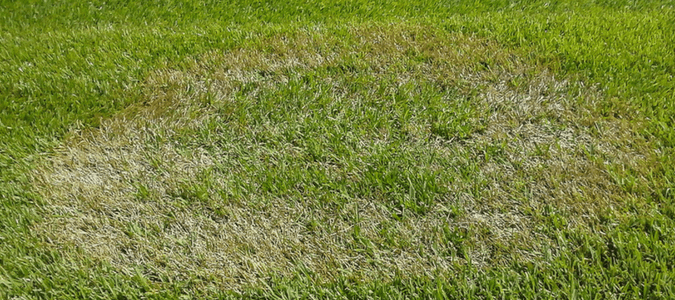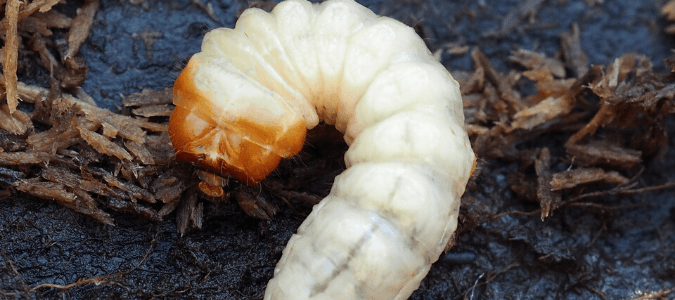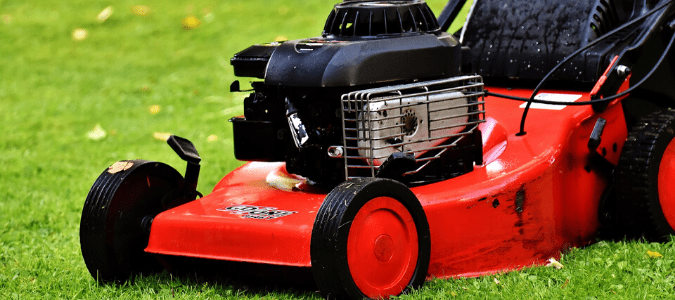
After putting lots of hard work into taking care of your lawn and creating a lawn care schedule, it’s frustrating to see that all that effort was for nothing. There are unsightly yellow spots in your grass and you’re unsure of what went wrong. You want to know what you can do to fix it.
There are several reasons why you might have yellow spots in your grass. These can include certain fungal diseases that various types of grass can be prone to, as well as pest infestations. Grubs and chinch bugs can cause patches of discoloration. If you have pets, particularly dogs, their urine can also cause yellow spots in grass, especially if they typically “do their business” in one area. Fortunately, there are steps you can take in each of these cases to mitigate the discoloration and help return your grass to a thick, green state.
Pet Urine
One of the most common causes of yellow spots in grass is an excess of nitrogen. This can occur for a couple of different reasons. Grass needs nitrogen to thrive, but too much of this mineral in the soil causes it to turn yellow. Animal urine, and particularly dog urine, contains a high concentration of immediately available nitrogen and will burn the grass. Add to that the fact that many dogs are creatures of habit that prefer to use the same area again and again for elimination, and you have a perfect prescription for nitrogen buildup in certain spots. If you have a dog, try to have your pet use different locations in the yard to urinate instead of the same one repeatedly. Use a hose to spray down the grass after the dog finishes doing its business.
Excess Fertilizer
Some types of fertilizer and compost also contain high amounts of nitrogen. Using too much of these products in your yard can cause grass discoloration. Exessive nitrogen causes grass to yellow because it changes the soil’s pH and burns the grass’s roots. The good news is, it’s relatively easy to avoid nitrogen buildup in your yard if you don’t overfertilize, since this mineral is easily dispersed by watering after the application.
Before using fertilizer or compost, you might check the bag for the product’s mineral content to get an idea of what you’re about to add to your soil. You can also test your soil itself to gain more specific information about which type of fertilizer you should be using. Be careful about using compost or fertilizer too often, since runoff from these products not only harms grass but some products can harm rivers and lakes.
Lawn Pests
Pests can also cause yellow discoloration in grass. St. Augustine grass is a popular choice for a lush lawn, but it is prone to chinch bug infestations. Zoysia and bermuda grass can both be susceptible as well. These insects leech nutrients from grass as they feed on its roots. They can cause extensive grass discoloration and even die-off in high numbers. They feed in ever-widening areas. This means that discolored patches caused by chinch bugs will grow asymmetrically over time.
Grub can also cause grass discoloration; also called grubs or white grubs, these are the larval stage of Junebugs. This is a beetle common in Texas and other areas. Like chinch bugs, grubs feed on the roots of grass and other plants. They slowly deplete their nutrients over time, causing discoloration and death to the turf.
Increasingly, residential areas are seeing damage from billbugs. These are a species of snout beetle or weevil that feeds on grass roots. Management of these types of pests involves basic lawn maintenance practices. These include good lawn maintenance like mowing on a regular basis, aerating, avoiding overuse of fertilizer, cutting the grass too short and raking out thatch buildup as needed.
Fungal Diseases
Grass is also susceptible to certain types of fungal diseases that can cause yellow or brown discoloration, such as brown patch and root rot. St. Augustine, bermuda grass and zoysia are all susceptible to fungal diseases, especially when the weather turns warm and humid. Fungal patches are typically roughly circular in shape and spread over time, if not addressed. Just as with pest infestations that cause discoloration in grass, prevention through regular lawn maintenance is the best cure for fungal diseases in your yard.
Many people find it daunting to keep up with lawn maintenance, but it doesn’t have to be a chore. A basic, minimal lawn care schedule might include watering once or twice a month, or more often during the hottest months of the year. It also includes mowing twice a month throughout the primary growing season (spring through summer and into early fall); fertilizing each spring, and again in the fall if needed. Finally, it’s important to aerate once a year, typically in the late spring.
Many people who find it difficult to keep up with this regimen find it far simpler and more effective to hire a lawn care specialist to keep up with the maintenance throughout the year. Lawn care professionals can determine the exact cause of any discolored patches. They can also handle everything from routine maintenance to resolving any problems that might arise.

Common Lawn Grub Signs
Another common cause of yellow or brown patches in grass is grubs, also known as white grubs. These aren’t actually worms. They are the larval stage of various types of beetle, such as junebugs or Japanese beetles. Common lawn grub signs include wilted, discolored areas in your grass, along with the presence of actual grubs in the soil. You might find grubs when you dig a hole while gardening. If you have noticed skunk or mole activity in your yard or you see crows spending lots of time on the grass, that may be another sign that you have a grub worm infestation. Increasing weeds in discolored grass can be another lawn grub sign.
Grub worms are whitish in color, with fat, curled, segmented bodies, small brown heads and six little feet clustered on their bodies just behind their heads. Japanese beetle grubs are smaller—about a half-inch to an inch long. Junebug grubs grow somewhat larger. Depending on their species, they can grow up to several inches in length and a half-inch or more in diameter. Grubs are bad for grass because they feed on grass roots and the roots of other plants growing in the yard. They deplete these plants’ nutrients over time.
Another lawn pest that is becoming a problem for homeowners is the hunting billbug. Many homeowners who have problems with hunting billbugs misidentify the problem as drought, dormancy, disease or another white grub. It can be difficult for homeowners to identify hunting billbug grubs because they are even smaller than other types of white grubs. They also don’t have those little feet by their head. Also, adult billbugs come out to feed on grass after the sun has gone down. So you likely won’t find these beetles unless you go hunting for them at night. Billbug damage can resemble dollar spot disease infections, with small spots of dying and yellow grass.
Look Underneath the Grass
One way to determine whether or not grubs are causing damage to your lawn is to cut a square foot of lawn about two to four inches deep and lift it up. If you see less than five grubs, you don’t need to treat your lawn for pests. A population of six to nine grubs means that you don’t need to treat your lawn unless you’re finding that animals are digging up your lawn to get to the grubs. If you’re seeing more than ten grubs, you’ll likely need to implement a pest control plan for your lawn.
The best way to keep grub worms from infesting your lawn and killing off your grass is to follow a regular lawn maintenance schedule. Mow regularly—twice a month during spring and summer and less often in fall and winter. Take care not to cut the grass too short. If you want to fertilize, test your soil to see how much fertilizer you should apply. Aerate once a year and remove thatch as it builds up in the grass. Many people prefer to hire a lawn care specialist to take charge of yard maintenance throughout the year. These lawn professionals can also diagnose and resolve problems as they develop, including any needed interventions for lawn pest control.

How to Fix Yellow Grass
For people wondering how to fix yellow grass, there’s good news. There are several simple steps most homeowners can take to deal with yellow patches in grass and prevent them from happening again.
The first step, as we have mentioned before, is to follow a regular lawn maintenance schedule, which includes following this guidance:
- Mow regularly, taking care not to cut the grass too short. During the prime growing season—spring and summer—this typically means mowing once a week. You can mow less often as the seasons change.
- Don’t water the grass too frequently or too often. Instead, water deeply on a less frequent basis, according to your region’s climate.
- Fertilize grass cautiously. Try to choose the right product based on its mineral content. Don’t use too much at one time.
- Aerate your grass to help its roots get much-needed minerals and air flow. If you are wondering how often to aerate your lawn, consult with a lawn care specialist in your area.
The above steps will go a long way toward preventing fungal diseases in your yard and pest infestations that can cause yellow patches in grass. When yellow grass patches occur, you can fix them by implementing strategies to maintain a healthy lawn. You can also hire a lawn care specialist to recommend the optimal maintenance schedule tailored to your yard so you can enjoy a welcoming and beautiful outdoor space.
ABC Can Keep Your Lawn Healthy and Green
The best way to prevent any problem with your lawn is to create a lawn care schedule that works best for the lawn type, soil type and sun exposure you have in your yard. Instead of spending your free time trying to determine what will work best for your particular situation, contact ABC Home & Commercial Services. Our lawn care specialists are highly-trained and can provide you with routine lawn care that keeps your lawn free of fungi, pests and other diseases.
